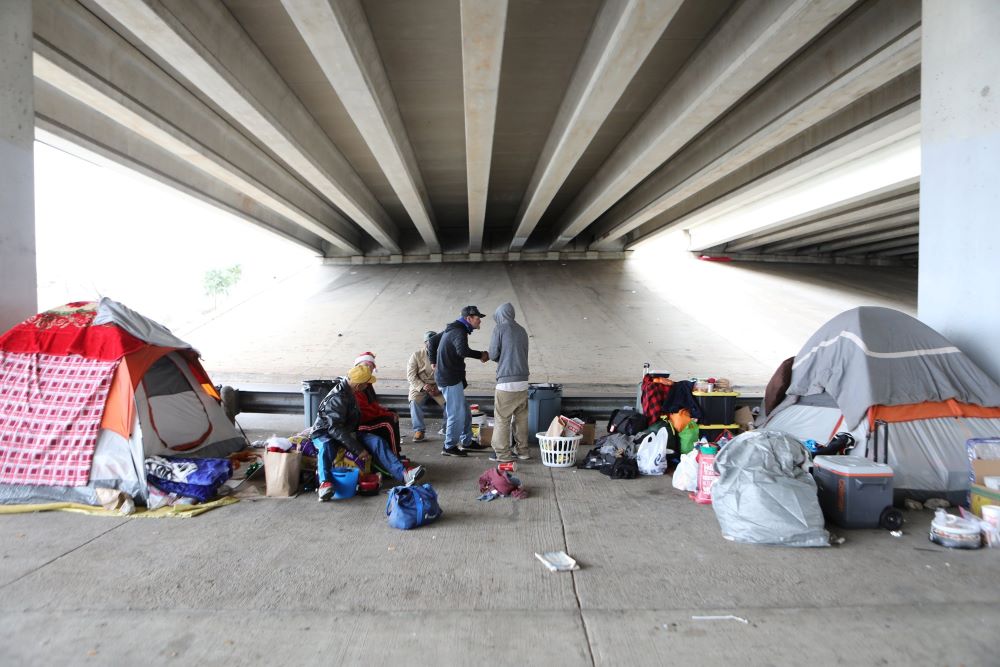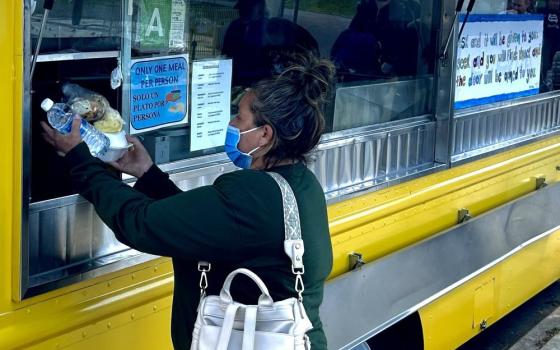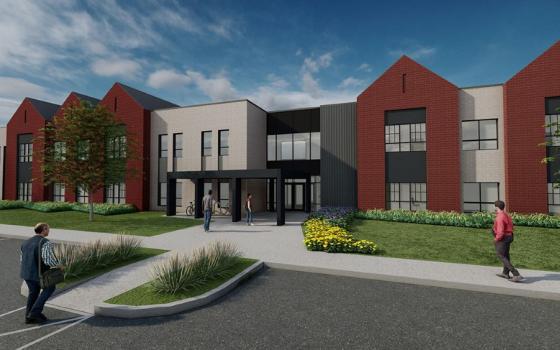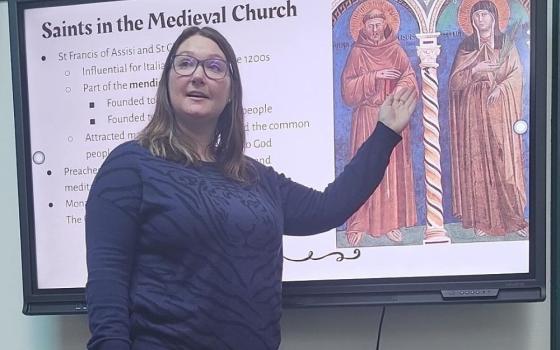
Homeless men in 2019 are seen outside their tents under a bridge in Austin, Texas. People 65 and older are the fastest growing population of unhoused people in the U.S. (OSV News/CNS file, Bob Roller)
Pope Francis is notoriously critical of what he calls a "culture of waste" or "throwaway culture" fostered under capitalist economies, characterized by indifference to human and ecological need in pursuit of consumption and profit. In a throwaway culture, one is only as good and worthy of care — as what one can produce. This problem, which impacts us all, does not spare our elders.
Older Americans are currently experiencing housing insecurity and homelessness at rates not seen in decades. That people 65 and older are the fastest growing population of unhoused people is the latest sign of the intensifying brutality of economic life in the United States.
Today's economy is such that it forces older adults, especially the poorest and racial and ethnic minorities, to choose each month which of their fundamental needs they will meet, and which they will neglect. In the housing literature, "cost-burdened" and "severely cost-burdened" mean that households spend 30% and 50%t of their income, respectively, on housing costs. Nearly a third of renters over 50 are severely housing cost burdened. The poorest spend half as much on food and out-of-pocket health care costs compared to their low-income peers who do not share the same housing cost burden.
It turns out that simply meeting needs is the solution to the problem of unmet needs.
For the American poor and working class, the United States is a worse place to grow old today than it was in years past. With so many living with such tight margins, they are an emergency away from experiencing homelessness. Predictably, the most common reasons why older people experience homelessness for the first time: the common, largely preventable cruelties of life for which there is little to no social insurance in the U.S.: rent increases, family dissolution, illness.
"The fact that we are seeing elderly homelessness is something that we have not seen since the Great Depression," University of Pennsylvania social policy professor Dennis Culhane told the Wall Street Journal in a recent interview. Indeed, the transformation over the last 30 years has been remarkable. In her 2020 article for the journal American Society on Aging, Margaret Kushel notes that in the early 1990s, among homeless single adults, only 11% were age 50 or above. Today, half that population is 50 or older.
Importantly, these people are not solely the long-abandoned, chronically homeless. The study found that half the 50 and over homeless population first experienced homelessness at age 50 or older. Indeed, according to the U.S. Department of Housing and Urban Development’s (HUD) 2021 Annual Homeless Assessment Report, while the number of adult-only households with people age 55 to 64 decreased, this same demographic saw an increase in experiences of chronic homelessness, suggesting that people are simply aging out of homes and into shelters and the streets.

Cots for the homeless are lined up in the Parish Life Center at St. Jude the Apostle Church in Lewes, Delaware, Nov. 11, 2022. Nearly a third of renters over age 50 are severely housing cost burdened, meaning their household spends 50% of their income on housing costs. (OSV News/The Dialog/Michael Short)
There's another, more fundamental reason why the increase cannot be attributed to chronic homelessness: Homelessness is a death-dealing phenomena. Unhoused people simply die too young for chronic homelessness to be the cause of the escalating median age. The average life expectancy of a homeless person is 17.5 years shorter than the general population's — just over 56 for men and 52 for women. Premature death is among the ways we "solve" homelessness. The social dislocation, the stress, the stigmatization, the need to prioritize the most basic survival needs are daily catastrophes on the human body and mind.
It should not be this way. From the standpoint of Catholic social teaching, it is the role of the government to create a climate in which individuals can pursue both their rights and responsibilities. In 21st century America, when the cost of rent routinely outpaces the rate of inflation, that means significant political and economic changes to housing. When the majority of Americans cannot afford a $1,000 life emergency, that climate simply does not exist here.
It does not have to be this way. There are achievable policy measures we can strive for and win now, regardless of party affiliation. We need a two-track mind when it comes to policy solutions. Our social safety net should be geared toward preventing the worst-case scenarios, but capable of humane reaction to catch those who, for whatever reason, slip through. Right now, with few exceptions, we barely do either. However, there are success stories. While imperfect, the effort to house military veterans has been a remarkable success in a relatively short period of time when a housing-first model was adopted during the Obama administration.
Housing-first models place a low barrier to entry for getting off the streets and out of shelters. It does not require, for instance, would-be participants to resolve substance abuse issues before they are admitted. Rather, housing is the foundation upon which other quality of life improvements are made, usually through supportive services offered by or in conjunction with the housing provider.
The Obama administration used a program that combined the human services and case management resources of the Department of Veterans Affairs with $635 million worth of HUD housing vouchers between 2008 and 2016. There has been a 55.3% reduction in the number of veterans experiencing homelessness between 2010 and 2022.
It turns out that simply meeting needs is the solution to the problem of unmet needs.
Citizens should advocate for a similar housing-first approach that takes a holistic view to providing supports that seniors need: accessible design, transportation and community. There are no federal rent controls imposed on the private housing markets. In the context of a national housing shortage, property owners are empowered to raise rents as high as they please and as high as their local markets can bear. So it’s not surprising that a July 2023 study of data from the St. Louis Fed found that since 1985, rent increases have outpaced the rate of inflation by 40%.
If rent had increased at the same rates, the average renter would pay 19% less per month.
Another policy solution is automatic enrollment in the Supplemental Nutrition Assistance Program (or SNAP, formerly food stamps). Fewer than half of all SNAP-eligible people age 60 and older are enrolled in the program. Our policies should map onto basic shared human experience. It is common enough for our physical vulnerability to increase as we age for us to plan around that simple fact. We should not wait for people to experience and then demonstrate need in an application for us to supplement their food allowance. In a country that routinely wastes nearly 40% of its food, every empty stomach is a scandal.
Advertisement
The most fundamental problem, however, is that housing can never be treated as a human right as long as it is largely market-based. Housing in the United States is almost entirely private: In 2019, only 11% of renting households, or 5 million households, obtained housing through a HUD program such as public housing, Section 8 or housing-choice vouchers. Even among that lot, the latter two programs consist of public funds being poured into the private market.
Markets, and the profit motive that moves them, cannot guarantee rights. Rights are political. The ideal aim of politics — namely, justice — is not always profitable. Only large-scale political transformation can change the precarious situation of our elders.
On Oct. 4, Pope Francis published a new document on the ecological crisis, Laudate Deum. In it, he gives us a good shorthand summary of what he means by "integral ecology," by describing his two deep-seated convictions that, "Everything is connected" and "No one is saved alone." This is more than just a picture of the environment and our place in it; it’s also an account of our life together as human beings.
Perhaps, then, we might also add "No one is abandoned alone" to see its policy implications. The affordable housing crisis demonstrates that this framework contains just as much realpolitik as it does moral content: Most of us are at risk in any system that so easily throws away its most vulnerable members.
[This article was made possible by a grant from the Hilton Foundation.]







